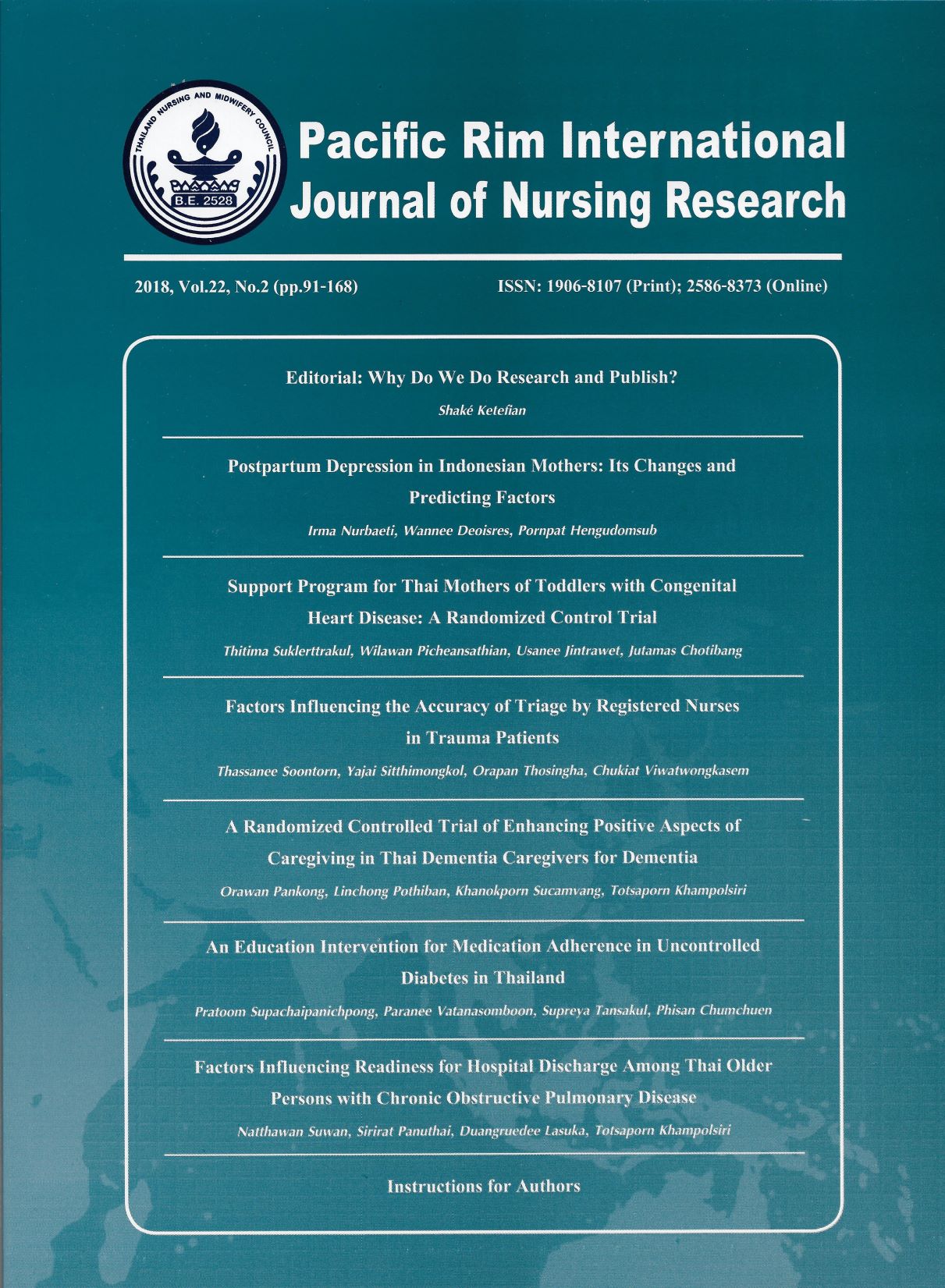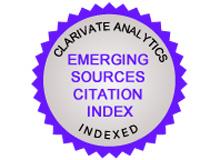Postpartum Depression in Indonesian Mothers: Its Changes and Predicting Factors
Keywords:
Childcare stress, Indonesia, Life stress, Mothers, Postpartum depression, Marital satisfaction, Self-esteemAbstract
Postpartum depression is a serious mental disorder that affects 10%-20% mothers and occurs mostly within the first three months after birth. The purpose of this study was to explore the changes in postpartum depression over three months and to investigate selected predictors including childcare stress, marital satisfaction, self-esteem, life stress, social support, family income, and baby gender preference on changes in depression over three months’ postpartum. A prospective longitudinal study was carried out in a sample of 283 mothers at 1, 2 and 3 months postpartum. The participants were recruited by cluster sampling during January – June 2016 from four public health centers in Indonesia. Postpartum depression was assessed using the Indonesian version of the Edinburg Postnatal Depression Scale. Data were collected at home visits. A one-way repeated measure ANOVAand Multilevel Linear Modeling wereperformedfor statistical analysis.
Results showed that the prevalence of postpartum depression was 18.37%, 15.19%, and 26.15% at one, two and three months, respectively. The mean scores using the Scale increased significantly during the first 3 months postpartum. Predicting factors that affected the change in postpartum depression over the 3 months werechildcare stress, marital satisfaction, life stress, and non-acceptance of baby gender. These findings emphasize the need for nurses to screen for maternal depressive symptoms and design intervention programs to alleviate postpartum depression.
References
2. American Psychiatric Association. Diagnostic and statistical manual of mental disorders (5th ed., text revision). Washington, DC;2013.
3. Hirst KP, Moutier CY. Postpartum major depression. Am Family Physician.2010;82: 926-933
4. Wang L, Wu T, Anderson JL, et al. Prevalence and risk factors of maternal depression during the first three years of child rearing. J Women’s Health. 2011; 20(5): 711- 718.
5. Muzik M, Morelen D, Hruschak J, et al. Psychopathology and parenting in mothers with depression and PTSD. JAffect Disord. 2016; 207: 242-250
6. Sharkey KM, Iko IN, Machan JT, et al. Infant sleep and feeding patterns are associated with maternal sleep, stress, and depressed mood in women with a history of major depressive disorder. Arch Women’s Mental Health. 2016; 19:209–218
7. Boratav HB, Toker O, Kuey L. Postpartum depression and its psychosocial correlates: A longitudinal study among a group of women in Turkey.Women Health. 2016;56(5): 502-521
8. Werner E, Miller M, Osborne LM, et al. Preventing postpartum depression: review and recommendations. Arch Women’s Mental Health. 2015; 18:41–60.
9. Halbreich U, Karkum S. Cross-cultural and social diversity of prevalence of postpartum depression and depressive symptoms. J Affect Disord. 2006; 91:97-111
10. Gordis, L. Epidemiology (4th ed). Philadephia: WB Saunders; 2014.
11. YusuffASM, Tang L, Binns CW, et al. Prevalence and risk factors for postnatal depression in Sabah, Malaysia: A cohort study. Women and Birth. 2014;28, 25–29
12. Andajani-Sutjahjo, MandersonL, Astbury J. Complex emotions, complex problems : Understanding the experiences of perinatal depression among new mothers in urban Indonesia .Cult Med Psychiatry. 2007; 31(1): 101-122.
13. Idaiani S, Basuki B. Postpartum depression in Indonesian women: A national study. Health Science J Indonesia. 2012; 3(1): 3-8
14. Klainin P, Arthur DG. Postpartum depression in Asian cultures: A literature review. Int J Nurs Stud. 2009; 46, 1355-1373
15. Ministry of Health Republic of Indonesia. Basic Health Statistics Profile of Indonesia 2013. Jakarta : Ministry of Health Republic of Indonesia. 2014.[in Bahasa Indonesia].
16. Beck CT. Predictors of postpartum depression: An update. Nurs Res. 2001; 50: 275-285.
17. Brown JD, Harris SK, Woods ER, et al. Longitudinal study of depressive symptoms and social support in adolescent mothers. Matern Child Health J. 2012; 16: 894-901
18. Haga SM, Ulleberg P, Slinning K, et al. A longitudinal study of postpartum depressive symptoms: Multilevel growth curve analyses of emotion regulation strategies, breastfeeding self-efficacy, and social support. Arch. Women’s Mental Health. 2012; 15: 175-184
19. Falah-Hassani K, Shiri R,Dennis CL. Prevalence and risk factors for comorbid postpartum depressive symptomatology and anxiety. J Affect Disord. 2016; 198: 142–147
20. Kheiderabadi GR, Maracy MR, Barekatain M, et al.Risk factors of postpartum depression in rural areas of Isfahan province, Iran. Arch Iranian Med. 2009; 12(5): 461 – 467
21. Tychey CD, Briancon S, Lighezzolo J. Quality of life, postnatal depression and baby gender. J Clin Nurs. 2008; 17, 312 – 322
22. Xie RH, Yang J, Liao S, et al.Prenatal family support, postnatal family support and postpartum depression.Aust N Z JObstet Gynaecol. 2010; 50 (4): 340–345.
23. Hair JF, Black WC, Babin BJ, et al. Multivariate data analysis (7th ed). Harlow, United Kingdom : Pearson Education Limited. 2014.
24. Cox JL, Holden JM, Sagovsky R. Detection of postnatal depression. Development of the 10-item Edinburgh postnatal depression scale. Br J Psychiatry. 1987; 150, 782-786.
25. Kusumadewi I, Irawati I, Elvira SD, et al. Validation study of the Edinburgh Postnatal Depression Scale. Indonesia Psychiatric Quart.1998; 21(2): 99-110
26. Bell AF, Carter CS, Davis JM,et al. Childbirth and symptoms of postpartum depression and anxiety: a prospective birth cohort study. Arch Women’s Mental Health. 2016; 19:219–227 DOI 10.1007/s00737-015-0555-7
27. Spanier GB. Measuring dyadic adjustment: new scales for assessing the quality of marriage and similar dyads. J Marriage and the Family. 1976; 38: 15-28
28. Rosenberg, M. Society and the adolescent self-image. Princeton, NJ: Princeton University Press; 1965.
29. Schmitt DP, Allik J. Simultaneous administration of the Rosenberg Self-Esteem Scale in 53 nations: Exploring the universal andculture-specific features of global self-esteem. J Pers Soc Psychol. 2005; 89(4): 623– 642
30. Norbeck JS. Modification of life event questionnaires for use with female respondents. Res Nurs Health. 1984; 7(1):67-71
31. Cutrona CE. Causal attributions and perinatal depression. J Abnormal Psychology.1983; 92(2): 161-172
32. Logsdon MC, Usui W, Birkimer JC,et al. The Postpartum Support Questionnaire: Reliability and validity. J Nurs Meas.1996; 4(2): 129-142.
33. HeckRH, Thomas SL, Tabata LN. Multilevel and Longitudinal Modeling with IBM SPSS. New York : Routledge. 2014.
34. Dennis CL, Ross L. Relationships among infant sleep patterns, maternal fatigue, and development of depressive symptomatology. Birth. 2005; 32:187–193. doi:10. 1111/j.0730-7659.2005.00368.x
35. Kettunen P, Koistinen E, Hintikka J. The connections of pregnant-delivery-, and infant-related risk factors and negative life events on postpartum depression and their role in first and recurrent depression. Hindawi Publishing Corporation Depression Research and Treatment. Article 2016. ID 2514317, 7 pages. https://dx.doi.org/10. 1155/2016/2514317
36. Hegde S, Latha KS, Bhat SM, et al. A. Postpartum depression: Prevalence and associated factors among women in India. J Women’s Health Care Issues.2012; 1(1): 1-7. doi:10.4172/2325-9795.1000101
37. Escriba-Aguir V, Artazcoz L. Gender differences in postpartum depression: A longitudinal cohort study. J Epidemiol Community Health. 2011;65:320-326
38. Nasiri S, Kordi M,Gharavi MM. A comparative study of the effects of problem-solving skills training and relaxation on the score of self-esteem in women with postpartum depression. Iran J Nurs Midwifery Res. 2015; 20(1): 105–112.
39. Silva R, Jansen K, Souza L, et al. Socio-demographic risk factors of perinatal depression: A cohort study in the public health care system. RBP Psychiatry. 2012; 34 (2): 143-148
40. Central Bureau Statistic of Indonesia. Monthly Report. Data of socio-economic 2017. Jakarta: Central Bureau of Indonesia. 2017 [in Bahasa Indonesia].
Downloads
Published
How to Cite
Issue
Section
License
Copyright: The Pacific Rim International Journal of Nursing Research, Thailand Nursing & Midwifery Council has exclusive rights to publish, reproduce and distribute the manuscript and all contents therein.








.png)



